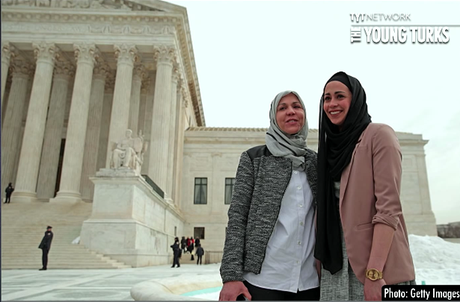
Samantha Elauf
In 2008, 17-year-old Samantha Elauf was denied a job at a Tulsa, Oklahoma Abercrombie Kids store. Why? The retailer did not believe her hijab complied with their “look policy.” Her headscarf was apparently an immediate indicator that she did not align with the “East Coast collegiate image” Abercrombie cultivates in its branding, the New York Times reported. Elauf was effectively informed that her Muslim identity was un-American.
Elauf fought this notion. She brought her story to the Council on American Islamic Relations, which then brought it to the attention of the Equal Employment Opportunity Commission. The EEOC sued Abercrombie & Fitch on Elauf’s behalf and the case eventually made it to the Supreme Court. In appellate court, Abercrombie’s defense argued that Elauf had not explicitly stated that she wears her hijab for religious reasons in her interview and that she should have formally requested religious accommodation.
The Supreme Court, however, ruled in an 8-to-1 decision that an employer’s unsubstantiated suspicion cannot excuse their refusal to hire anyone, meaning that Elauf should not have been required to file for a religious accommodation. Furthermore, she could not have been rejected under the 1964 Civil Rights Act due to its Title VII job anti-bias law. This new ruling invalidated Abercrombie’s defense (which was essentially a request for proof of Elauf’s religion), which not only required the company to change its policy but also closed a major loophole in religious discrimination.
This is largely how the case has been discussed so far. It is seen as a “historic ruling in defense of religious freedom at a time when the American Muslim community is facing increased levels of Islamophobia,” according to Nihad Awad, the national executive director of the Council on American-Islamic Relations. Indeed, Muslims file more job discrimination claims than any other religious group – an indication of many Americans’ lingering fear of terrorism and animosity towards anything related to Islam.
But this case also raises a larger question of not only what it’s like to be Muslim in America, but what it’s like to be a Muslim American woman. The hijab is part of Elauf’s feminine identity and is often a contested point of personal expression for many Muslim women. By citing their look policy, Abercrombie & Fitch expressed that their picture of American values is in fact an old-fashioned one, in which WASP-ish boys and girls flaunt expensive, sporty clothes and there is no context for one of those girls to wear the hijab.
The Supreme Court’s ruling, therefore, offers a hopeful alternative to this largely xenophobic understanding of what an “American” looks like. There is no reason “Islamic” should not mean “American” and this ruling encourages Abercrombie (and our cultural imagination at large) to modernize its presentation of the American aesthetic to include a more global perspective: Samantha Elauf can wear an Abercrombie & Fitch t-shirt and her headscarf at the same time.
In this way, the ruling is a victory not only for religious freedom of expression but also for feminist individuality. There will undoubtedly be countless instances of Islamophobia in the future. Elauf’s case may or may not be referenced in everyday life to prevent these future occurrences. But at this point in history, the Supreme Court has indicated that every girl and woman in this country has the right to combine her gender and religion in whatever ways she chooses — and that is certainly a step in the right direction.

